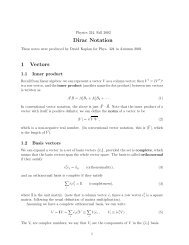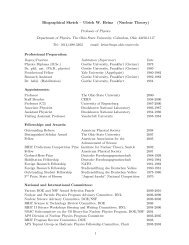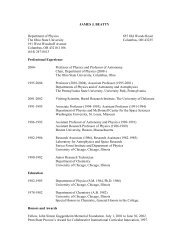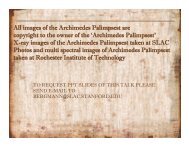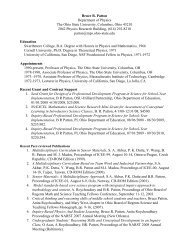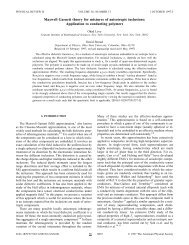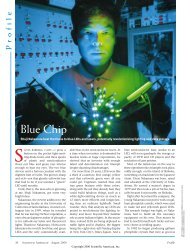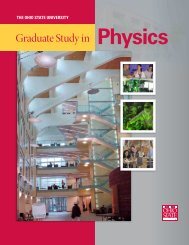You also want an ePaper? Increase the reach of your titles
YUMPU automatically turns print PDFs into web optimized ePapers that Google loves.
ITEM LEVEL<br />
The default assumption in the Player’s Handbook is<br />
that each magic item has a level that equates to both<br />
its cost and its suitability as part of a PC’s equipment.<br />
However, an item’s level doesn’t restrict its use by<br />
the PCs. A 1st-level fighter can freely use a +6 vorpal<br />
greatsword if he can somehow manage to acquire one.<br />
Alternatively, relative level can play a stronger<br />
part in how magic items function in your campaign.<br />
Although level doesn’t have a narrative equivalent in<br />
the game world, it does suggest a certain degree of<br />
inherent power within characters and their magic<br />
items alike. As such, any imbalance between the level<br />
of a character and the magic he or she wields can<br />
have repercussions in the game.<br />
Level-Based Penalties<br />
DMs should feel free to place restrictions on the way<br />
magic items function, according to their level. The<br />
standard treasure rules (which assume that PCs can<br />
find an item up to four levels higher than their own<br />
level) are a good place to start.<br />
It’s entirely reasonable to say that items five or<br />
more levels higher than a character simply don’t<br />
function in that character’s hands. Alternatively,<br />
limitations or penalties for powerful items used by<br />
lower-level characters can be assigned on an ad-hoc<br />
basis. For example, a powerful magic weapon might<br />
function at its normal level but impose a penalty to<br />
the wielder’s defenses. Likewise, a defensive item<br />
might penalize attack rolls, damage rolls, or both.<br />
An item that grants a bonus on a certain skill check<br />
might penalize other skill checks as its power overwhelms<br />
its user.<br />
More extreme penalties might function in the<br />
same manner as the behavior of artifacts (see Chapter<br />
9 of the Dungeon Master’s Guide). A character<br />
wielding high-level magic might be inspired (or even<br />
forced) to take up an item’s goals or purpose in the<br />
short term. For example, a 2nd-level character might<br />
feel the urge to give her excess wealth to charity<br />
under the influence of a +3 symbol of hope, while a<br />
10th-level paladin might be driven to seek revenge on<br />
the elder red dragon that killed the former owner of<br />
his +5 greatsword.<br />
DMs should use this technique sparingly, however,<br />
and only in the interest of advancing the campaign.<br />
It can be fun for a character to try to deal with the<br />
unexpected side effects of magic beyond his or her<br />
ability to effectively use. It’s typically less fun for the<br />
PCs’ magic items to limit their ability to choose their<br />
own path.<br />
Level Scaling<br />
In the interest of entertaining game play, sometimes<br />
a DM will want to place a magic item as treasure<br />
that is too high for the party’s current level. Other<br />
times, bravery and fortune sees the PCs defeat a foe<br />
and gain access to magic that the DM never intended<br />
them to have. In either case, an advanced magic item<br />
can have its power scaled back to a level usable by<br />
the PCs, with its additional power revealed over time.<br />
This technique works particularly well for items that<br />
have lower-level versions, but single-level items can<br />
be reworked to lower levels as well.<br />
For example, your world’s histories might speak of<br />
the legendary Travic’s Blade—a 25th-level holy avenger.<br />
If the DM decides to introduce the sword into the<br />
campaign when the PCs are lower level, he or she<br />
can do so by introducing a story hook that speaks of<br />
the blade’s powers being suppressed until certain<br />
conditions are met.<br />
If first found when the PCs are 12th level, the<br />
sword could function as a basic +3 sword—perhaps<br />
one that deals radiant damage on critical hits as a<br />
hint of its latent power. When its wielder is 15th level<br />
or so, the sword can increase its enhancement bonus<br />
to +4 and add a +2 item bonus to damage rolls done<br />
with radiant powers through the weapon.<br />
When the PCs ascend to a level suitable for the<br />
appearance of a holy avenger (21st level or higher), the<br />
blade finally attains the full power wielded by mighty<br />
Travic in the annals of history. It might even scale<br />
up again to become a 30th-level holy avenger when<br />
its wielder reaches 26th or 27th level, allowing its<br />
wielder to transcend the sword’s mythic past.<br />
Item Levels as Treasure<br />
Sometimes a magic item enters the campaign at the<br />
correct level, but a player wants her character to hold<br />
onto that item at higher levels rather than replacing<br />
it with a newer, higher-level item. The DM can<br />
allow the PC to invest monetary treasure in Enchant<br />
Magic Item rituals to increase the item’s power (see<br />
Enchanting Items, below). Alternatively, item level<br />
increases can be given out as treasure.<br />
Item levels granted as treasure follow the same<br />
guidelines as normal magic item placement. An<br />
increase in an item’s enhancement bonus should be<br />
given out only when the PCs have attained an appropriate<br />
level to earn magic items with the improved bonus.<br />
MAGIC ITEM SCALING<br />
Item Level Enhancement Bonus<br />
1–5 +1<br />
6–10 +2<br />
11–15 +3<br />
16–20 +4<br />
21–25 +5<br />
26–30 +6<br />
APPENDIX 1 | Unique Items<br />
APPENDIX 1<br />
197




